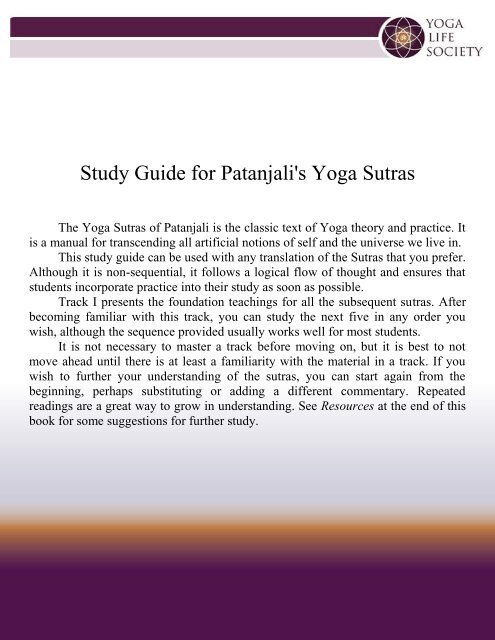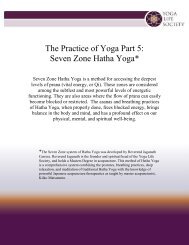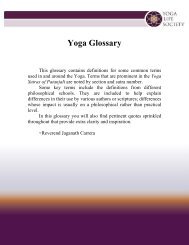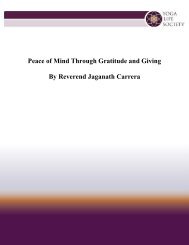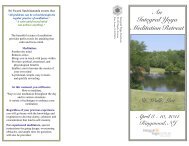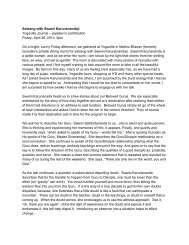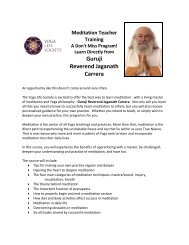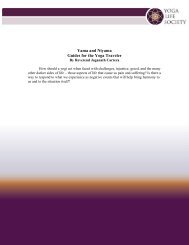Study Guide for Patanjali's Yoga Sutras - Yoga Life Society
Study Guide for Patanjali's Yoga Sutras - Yoga Life Society
Study Guide for Patanjali's Yoga Sutras - Yoga Life Society
- No tags were found...
Create successful ePaper yourself
Turn your PDF publications into a flip-book with our unique Google optimized e-Paper software.
<strong>Study</strong> <strong>Guide</strong> <strong>for</strong> <strong>Patanjali's</strong> <strong>Yoga</strong> <strong>Sutras</strong>The <strong>Yoga</strong> <strong>Sutras</strong> of Patanjali is the classic text of <strong>Yoga</strong> theory and practice. Itis a manual <strong>for</strong> transcending all artificial notions of self and the universe we live in.This study guide can be used with any translation of the <strong>Sutras</strong> that you prefer.Although it is non-sequential, it follows a logical flow of thought and ensures thatstudents incorporate practice into their study as soon as possible.Track I presents the foundation teachings <strong>for</strong> all the subsequent sutras. Afterbecoming familiar with this track, you can study the next five in any order youwish, although the sequence provided usually works well <strong>for</strong> most students.It is not necessary to master a track be<strong>for</strong>e moving on, but it is best to notmove ahead until there is at least a familiarity with the material in a track. If youwish to further your understanding of the sutras, you can start again from thebeginning, perhaps substituting or adding a different commentary. Repeatedreadings are a great way to grow in understanding. See Resources at the end of thisbook <strong>for</strong> some suggestions <strong>for</strong> further study.
Track I: The FoundationThis track lays the foundation of Raja <strong>Yoga</strong> theory and engages the student in practice as soon aspossible.The two pillars that support all of the theories and practices of Raja <strong>Yoga</strong> are presented in this track: thefirst sixteen sutras of Pada One and the eight limbs of Raja <strong>Yoga</strong> that are the major topic of Pada Two.<strong>Sutras</strong> 1.1–1.16Introduction to the basic philosophy; practice and nonattachment are introduced.<strong>Sutras</strong> 3.1–3.3These sutras, which introduce meditation, are included at this point in order to facilitate and encouragethe practice of meditation.<strong>Sutras</strong> 1.30–1.41These sutras cover the obstacles encountered in meditation and offer several possible objects ofmeditation to choose from; there<strong>for</strong>e the group nicely follows the sutras listed above. This group of sutras endswith our first exposure to a definition of samadhi, the superconscious state.<strong>Sutras</strong> 2.28–2.45The eight limbs are introduced. They reflect the central teachings and practices of Raja <strong>Yoga</strong>. In fact,many people know Sri Patanjali’s work as Ashtanga <strong>Yoga</strong>, the eight-limbed <strong>Yoga</strong>. These eight limbs bringtogether the principles of nirodha, discriminative discernment, nonattachment, moral and ethical precepts, andthe physical facets of <strong>Yoga</strong>—asana (posture) and pranayama (breath control).The sutras of this group focus on the first two limbs: the moral and ethical precepts of <strong>Yoga</strong>, known asyama and niyama.<strong>Sutras</strong> 2.46–2.55We continue the exploration of the limbs of <strong>Yoga</strong> with asana, pranayama, and pratyahara (sensewithdrawal). Their practice and benefits are introduced.<strong>Sutras</strong> 2.1–2.12, 2.14–2.17, 2.24–2.26, and 2.28.Since Track 1 emphasizes regularity in <strong>Yoga</strong> practice, it is important to become familiar with theobstacles that will be encountered and the method <strong>for</strong> their removal.We are introduced to karma (the law of cause and effect) in sutra 2.14, and in sutra 2.26 we find the firstsutra on viveka, discriminative discernment.Sutra 2.26 and 2.28 bring us full circle back to the eight limbs by presenting the connection between thepractice of the eight limbs and the discriminative insight necessary to remove ignorance.Track II: Meditation, Devotion, Obstacles<strong>Sutras</strong> 1.23–1.29This track discusses devotion as a viable means to Self-realization. It opens with sutras that describeIshwara (the Creator) as “the Supreme Purusha (Self) free from afflictions and karmas.”Also introduced are mantras as meditation techniques.At the end of this track, review sutra 1.30, on obstacles.
Track III: Samadhi<strong>Sutras</strong> 1.17–1.22 and 1.42–1.51This track describes the various samadhis (superconscious states).Since this material is technical in nature, it has been placed here to allow students time to begin apersonal practice and become familiar with the fundamental philosophical points.Be<strong>for</strong>e going on, review sutras 1.2 and 1.41.Track IV: The Nature of the Seer and Seen<strong>Sutras</strong> 2.18–2.27In this section, Sri Patanjali teaches us that Nature needs to be understood <strong>for</strong> the Self to be realized.This track takes us on a journey of exploration where we discover the distinction between Nature (Prakriti) andthe Seer (Purusha).Track V: Development in Nirodha and the Siddhis<strong>Sutras</strong> 3.4–3.55This group of sutras begins by examining how nirodha (restraint of the mental modifications) isdeveloped. It goes on to list the siddhis—the various accomplishments that can come as a result of <strong>Yoga</strong>practices.Track VI: Freedom<strong>Sutras</strong> 3.56–4.34This track restates some of what has been covered be<strong>for</strong>e but in more depth. There are a number ofsutras that discuss the topic of evolution. It also offers a breakdown of the seeker’s experiences as he or sheapproaches Self-realization.


